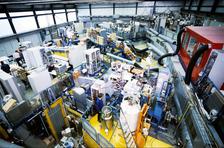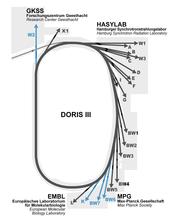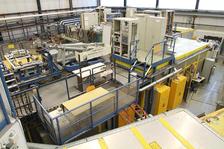DORIS III was a storage ring for charged particles before its shut down on 22nd Oct. 2012. The originally double ring store had been modified to a dedicated synchrotron source. Its circumference of 289 meters allowed to store positrons or electrons at an energy of 4.45 GeV and in bunched packages. Typcially 2 or 5 bunches of positrons were stored in DORIS III with an inital beam current of up to 120 mA. The corresponding time interval between the bunches was 480 nsec or 192 nsec.
Synchrotron radiation was produced in the curves of the ring (bending magnets) and in straight section where insertion devices were located (wigglers and undulators). The spectrum of DORIS III ranged from infrared radiation to hard X-rays, and was very intense particulary in the X-ray range.
About 33 beamlines guided the synchrotron light to the experimental stations located in the different experimental halls. About 40 different experiments were available at the experimental stations. Several beamlines were operated by outstations or external institutes like e.g. EMBL, MPG, HZG, GFZ, University of Hamburg, University of Kiel, RWTH Aachen. The experimental halls were equipped with all necessary infrastructure to perform experiments. Safety and warning systems helped to ensure a safe operation of the user facility DORIS III.










